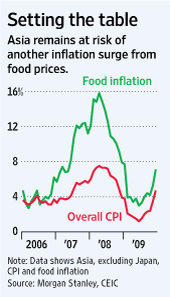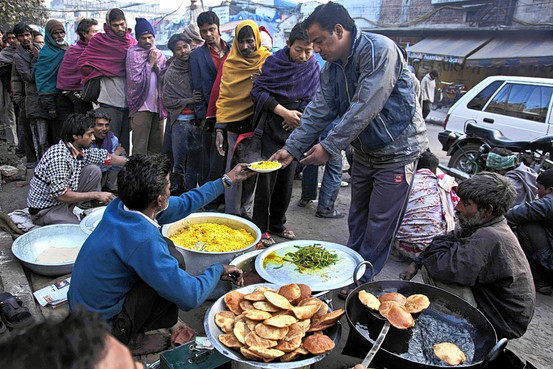Saturday, February 13, 2010 4:23:14 PM
Food Costs Are Stoking Asia Inflation
FEBRUARY 11, 2010,
10:01 P.M. ET.
By ALEX FRANGOS
HONG KONG—The rising cost of food is driving Asian inflation rates higher, increasing the stakes for a successful harvest this year in a region still bruised by the 2008 food crisis.

Prices for rice, sugar, milk, and in some places, fruits, vegetables and cooking oils, have risen in recent months, putting pressure on overall consumer prices. The region's most important economies, including India, China, Thailand and Indonesia, are all grappling with how to handle rising prices without snuffing out their economic rebounds. Food-price increases are leading to higher inflation rates across much of Asia, though energy costs and tighter labor markets are also putting pressure on prices.
Asia was hit hard in 2007 and 2008 when shortages of foodstuffs, especially rice, led to hoarding and riots. Armed guards were dispatched to protect rice warehouses in Thailand and the Philippines; Indonesia deployed border agents to prevent smuggling.
Some analysts warn that the structural issues that caused the 2008 food emergency—too much demand and not enough food—are still in place.
For now, prices aren't near levels that would create major dislocations. For example, in Bangkok, rice is trading at $592 a ton, according to the Thai Rice Exporters Association, after rising 10% from September through December to $618 a ton.
But prices are climbing and businesses hit by rising food costs in 2008 are again feeling the heat. Macquarie Group analysts recently downgraded Hong Kong fast-food company Café de Coral, citing higher food prices. Many of Café de Coral's dishes are a combination of meat and rice.
A company spokesman said in an email that food prices are a challenge.
"We are not able to raise prices across the board and we have to absorb a substantial portion of the increases," the Café de Coral spokesman said. "We will need to change the menus periodically to accommodate some of these increases."

India is particularly vulnerable, after suffering a dry monsoon in 2009 that led to double-digit food inflation as rice and sugar crops failed.
In the Philippines, too much rain ruined crops last year and forced the state to purchase almost two million tons of rice from abroad. As it ramped up purchases, prices at government-run auctions went from $480 a metric ton in early November to as high as $689 in mid-December, according to the National Food Authority.
Food prices in Asia make up a greater portion of consumer spending than in other parts of the world. In developing Asia, food makes up 34.5% of consumer prices, according to HSBC economists, compared with about 15% in the U.S.
In some countries such as India and Vietnam, the cost of rice alone has a bigger impact on inflation levels than energy costs. A 20% increase in rice prices regionally adds 1.5 percentage points to inflation. A 50% jump adds 3.7 percentage points, according to HSBC.
Over the short term, policy makers are counting on a good growing season this year to swell supply and keep prices stable. Early signs are promising.
"The March-April crop is more or less in the bag," says Chetan Ahya, economist at Morgan Stanley in Singapore. He predicts inflation across the region will continue to accelerate for a few more months before leveling. The real test will come with the larger autumn harvest, he says.
In Indonesia, food prices in January rose 3.72% from a year earlier, a faster pace of inflation than the 2.78% rate recorded in December. Indonesia's central bank kept its benchmark interest rate steady last week, saying the recent jump in the level of inflation was "temporary," driven by prices of food, especially rice, and that the coming rice harvest will increase supply.
Some forecasters say the El Niño phenomenon behind last year's extreme weather could fade by the summer.
India has held off from importing rice—a move that would have sent prices on the international market even higher. A weak global economy also limits demand for biofuels, taking pressure off crops such as corn, which is used to make ethanol.
Asian governments, including India, have stockpiled reserves of rice and wheat.
A crisis, however, can't be ruled out. Another dry monsoon season would pose serious problems for India.
World-wide demand for cereals remains precariously close to overall production levels, according to the United Nation's Food and Agriculture Organization.
"My fundamental belief is that we are in short supply," says Jeremy Zwinger, chief executive of the Rice Trader Inc., an industry research and news service.
An unexpected bad harvest could cause governments to react by hoarding food and blocking exports, sending prices skyrocketing.
Write to Alex Frangos at alex.frangos@wsj.com
FEBRUARY 11, 2010,
10:01 P.M. ET.
By ALEX FRANGOS
HONG KONG—The rising cost of food is driving Asian inflation rates higher, increasing the stakes for a successful harvest this year in a region still bruised by the 2008 food crisis.

Prices for rice, sugar, milk, and in some places, fruits, vegetables and cooking oils, have risen in recent months, putting pressure on overall consumer prices. The region's most important economies, including India, China, Thailand and Indonesia, are all grappling with how to handle rising prices without snuffing out their economic rebounds. Food-price increases are leading to higher inflation rates across much of Asia, though energy costs and tighter labor markets are also putting pressure on prices.
Asia was hit hard in 2007 and 2008 when shortages of foodstuffs, especially rice, led to hoarding and riots. Armed guards were dispatched to protect rice warehouses in Thailand and the Philippines; Indonesia deployed border agents to prevent smuggling.
Some analysts warn that the structural issues that caused the 2008 food emergency—too much demand and not enough food—are still in place.
For now, prices aren't near levels that would create major dislocations. For example, in Bangkok, rice is trading at $592 a ton, according to the Thai Rice Exporters Association, after rising 10% from September through December to $618 a ton.
But prices are climbing and businesses hit by rising food costs in 2008 are again feeling the heat. Macquarie Group analysts recently downgraded Hong Kong fast-food company Café de Coral, citing higher food prices. Many of Café de Coral's dishes are a combination of meat and rice.
A company spokesman said in an email that food prices are a challenge.
"We are not able to raise prices across the board and we have to absorb a substantial portion of the increases," the Café de Coral spokesman said. "We will need to change the menus periodically to accommodate some of these increases."

India is particularly vulnerable, after suffering a dry monsoon in 2009 that led to double-digit food inflation as rice and sugar crops failed.
In the Philippines, too much rain ruined crops last year and forced the state to purchase almost two million tons of rice from abroad. As it ramped up purchases, prices at government-run auctions went from $480 a metric ton in early November to as high as $689 in mid-December, according to the National Food Authority.
Food prices in Asia make up a greater portion of consumer spending than in other parts of the world. In developing Asia, food makes up 34.5% of consumer prices, according to HSBC economists, compared with about 15% in the U.S.
In some countries such as India and Vietnam, the cost of rice alone has a bigger impact on inflation levels than energy costs. A 20% increase in rice prices regionally adds 1.5 percentage points to inflation. A 50% jump adds 3.7 percentage points, according to HSBC.
Over the short term, policy makers are counting on a good growing season this year to swell supply and keep prices stable. Early signs are promising.
"The March-April crop is more or less in the bag," says Chetan Ahya, economist at Morgan Stanley in Singapore. He predicts inflation across the region will continue to accelerate for a few more months before leveling. The real test will come with the larger autumn harvest, he says.
In Indonesia, food prices in January rose 3.72% from a year earlier, a faster pace of inflation than the 2.78% rate recorded in December. Indonesia's central bank kept its benchmark interest rate steady last week, saying the recent jump in the level of inflation was "temporary," driven by prices of food, especially rice, and that the coming rice harvest will increase supply.
Some forecasters say the El Niño phenomenon behind last year's extreme weather could fade by the summer.
India has held off from importing rice—a move that would have sent prices on the international market even higher. A weak global economy also limits demand for biofuels, taking pressure off crops such as corn, which is used to make ethanol.
Asian governments, including India, have stockpiled reserves of rice and wheat.
A crisis, however, can't be ruled out. Another dry monsoon season would pose serious problems for India.
World-wide demand for cereals remains precariously close to overall production levels, according to the United Nation's Food and Agriculture Organization.
"My fundamental belief is that we are in short supply," says Jeremy Zwinger, chief executive of the Rice Trader Inc., an industry research and news service.
An unexpected bad harvest could cause governments to react by hoarding food and blocking exports, sending prices skyrocketing.
Write to Alex Frangos at alex.frangos@wsj.com
Not compensated in any manner for research and/or posts. Information should be construed as information only for discussion purposes. Always conduct your own dd. Just my opinion
Join the InvestorsHub Community
Register for free to join our community of investors and share your ideas. You will also get access to streaming quotes, interactive charts, trades, portfolio, live options flow and more tools.









